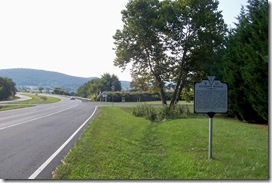 Fauquier County, VA
Fauquier County, VA
Marker No. B-20
Marker Text: After a day's march from Winchester on 19-20 July 1861, Brig. Gen. Thomas J. "Stonewall" Jackson halted his lead brigade of Gen. Joseph E. Johnston's Valley army near here. At 2:00 A.M. his 2,500 men sank down to rest. When told that no sentries had been posted, Jackson stated, "Let the poor boys sleep. I will guard the camp myself." Relieved of his duty an hour before daybreak, Jackson slept briefly, rising at dawn to march to Piedmont Station (now Delaplane), where railcars waited to transport the 11,000-man army to Manassas Junction. There, nearly 30,000 Confederates faced 35,000 Federals at the First Battle of Manassas.
Location: On U.S. Route 50 (John Mosby Highway), west of the intersection with U.S. Route 17, near Paris, VA. Erected by the Department of Historic Resources in 1996.
At first glance this lone marker on U.S. Route 50, near the small village of Paris, VA appears to simply mark the site where Thomas J. Jackson's brigade spent the night. Much more lies just below the surface. Jackson had only been promoted to Brig. Gen. two days before he marched his brigade under the command of Joseph E. Johnston's Army of the Shenandoah from Winchester, VA to aid General P. G. T. Beauregard in what was to become the First Battle of Manassas or Bull Run. Jackson's troops were about to make history by being the first troops transported to a battle by the railroad. The marker calls Jackson, “Stonewall” Jackson, but at this point he would not gain this nickname until July 21 during the Battle of First Manassas.
 Photo taken looking east on U.S. Route 50 with the intersection for U.S. Route 17 in background, where you would turn right or south to go to Piedmont Station.
Photo taken looking east on U.S. Route 50 with the intersection for U.S. Route 17 in background, where you would turn right or south to go to Piedmont Station.
An earlier marker that was replaced with the current marker with the same number and title from the late 1920s or 1930s. The text of that marker read “Near here Jackson’s men, going to First Manassas, sank down to rest, July 19, 1861, without placing pickets. Jackson said ‘Let the poor fellows sleep, I will guard the camp myself.’”
The events leading up to the Battle of First Manassas began several months before while both developing armies made plans for a fight, they both thought would be over with quickly. Due to Virginia's strategic location in the newly formed Confederacy potential military targets needed protected or taken. Both sides knew of the significance of the Manassas Gap Railroad and the uses of the Shenandoah Valley as a path of invasion to Richmond, the confederate capital.
This photo is looking east through the village of Paris, VA. This road is the older road that Jackson’s troops would have traveled. Route 50 was re-routed slightly north of this road several years ago.
Thomas J. Jackson was appointed a Colonel to begin recruiting and training soldiers to protect the Shenandoah Valley from Harper's Ferry and points south along the valley. Later, Joseph Johnston was placed in charge of the confederate Army of the Shenandoah. In early June, Union General Robert Patterson was given the task of forming an army in and around Chambersburg, Pennsylvania. Then he was to march south to take Harpers Ferry and defeat or at least fully occupy Johnston' Confederates.
Meanwhile, the federal government was developing a substantially larger army in Washington under the command of General Irvin McDowell. The confederate President Jefferson Davis appointed General P. G. T. Beauregard who had just a few months before commanded the capture of Fort Sumter. Beauregard was to establish an army along the Manassas rail lines, while Johnston protected the Shenandoah Valley.
The plan was for Union Gen. Patterson to keep Johnston's troops busy in the Shenandoah Valley in and around areas north of Winchester, so that Johnston could not reinforce Beauregard in Manassas once McDowell began his attack. As would frequently happen during the Civil War, commanders, like Patterson were not up to the tasks they were assigned and acted too cautiously. Patterson thought that if he looked like he was threatening that would keep Johnston in Winchester.
The road to the village of Paris is behind this marker on the right about 100 feet.
By July 18th, Johnston recognized that Patterson was most likely not intending to actually attack his forces. Apparently, Patterson believed that Johnston's forces were much larger than they were in fact. Johnston's troops left their camp at Winchester about noon, July 18th, with Jackson's brigade leading the march. When the rear of the command was a mile or two beyond Winchester, all the different regiments were at the same time informed of the necessity for a forced march.
Johnston was greatly discouraged by the slow rate of marching of his new and mostly green troops and the frequent delays. Johnston realized that they would most likely not arrive in time to aid Beauregard simply by marching the army to Manassas. Johnston sent his engineers to Piedmont station of the Manassas Gap railroad, the nearest one on his line of march through Ashby's gap (just west of this marker), to ascertain whether railway trains could be found to transport the troops quicker than they could by marching and to make the necessary transportation arrangements.
The head of Jackson's brigade reached Paris, (location of this marker) 17 miles from Winchester about two hours after dark. The four other brigades halted for the night along the road back to Winchester stretching out for four miles. The army would turn south at Paris to reach Piedmont Station the next morning. From the time, Johnston's troops left Winchester until their arrival in Manassas must have been very stressful and anxious days.


No comments:
Post a Comment